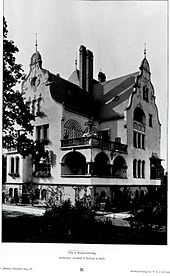Villa Neisser
The Wroclaw Villa Neisser was built in 1897/98 by the Berlin architect Hans Grisebach at Fürstenstrasse 124 (now Aleja Ludomira Różyckiego) on Scheitniger Park near the later Wroclaw Centennial Hall for the married couple Toni and Albert Neisser and destroyed by bombs in 1945.
description
Fritz Erler created the interior fittings for the hallway, the tea room (1905) and the conference room (1912). The music salon he designed "is considered the earliest example of an Art Nouveau room in Germany that was not designed for an exhibition but for a specific practical purpose." The house was richly furnished with art treasures.
After the death of the childless couple, the villa and the art collections were donated to the city of Wroclaw, which set up the house as part of the municipal collections and opened it in 1920. Exhibitions were held in the villa until the 1930s, so in May and June 1930 there was an exhibition of 50 paintings from the Littmann collection . In early 1933, the last exhibition of works from the Littmann collection took place in the Villa Neisser, including many works by the painter Otto Mueller . The manager of the "Albert and Toni Neisser Municipal Art Collection" was most recently Karl Masner (1858–1936), a retired museum director. He had headed the Silesian Museum of Applied Arts and Antiquities .
Since the Neissers were of Jewish origin, the foundation was dissolved in 1936 "for racial reasons". The villa had not previously been used as an exhibition space, and its interior furnishings were also removed and distributed, “whereby much was lost: 'The art collection bequeathed to the city by non-Aryan donors does not correspond to the intellectual culture of the new era,' it says in the files of the magistrate. ”From March 1934, the city briefly used the villa as the official residence of the National Socialist Lord Mayor Helmut Rebitzki . Rebitzki lived only briefly in the Neisser house because he was soon relieved of his office. His successor decided not to use the house. A new user was only found in February 1936: the Reichsanstalt für das Deutsche Bäderwesen at the University of Breslau.
literature
- Conrad Buchwald : The house of Albert and Toni Neisser. A guide. Silesian Museum of Applied Arts and Antiquities, Breslau 1920 (further editions 1921, 1923, 1927).
- Piotr Łukaszewicz: Alberta i Toni Neisserów Cathedral. Zapomniany rozdział z dziejów wrocławskich muzeów. German summary, p. 57. In: “Roczniki sztuki ślaskiej”, 15.1991, pp. 39–57 ( digitized version ).
- Marius Winzeler: Jewish collectors and patrons in Wroclaw - from donation to "exploitation" of their art possessions. In: Coordination Office for the Loss of Cultural Property Magdeburg (Ed.) Andrea Baresel-Brand, Peter Müller (Red.): Collecting. Pens. Promote. Jewish patrons in German society. Magdeburg 2008, ISBN 978-3-9811367-3-9 , pp. 131-150.
Individual evidence
- ↑ http://www.silesiancollections.eu/Kolekcje/Neisser-Toni-1861-1913-Neisser-Albert-1855-1916-Breslau address
- ↑ KIPKE 1920 The small address book and city map of Breslau
- ↑ Piotr Łukaszewicz (1991), p. 57
- ^ Marius Piotr Łukaszewicz (1991), p. 57
- ^ Marius Winzeler (2008), p. 143
- ^ Marius Winzeler (2008), p. 145
- ^ Marius Winzeler (2008), p. 145
- ↑ Piotr Łukaszewicz (1991), p. 57
Coordinates: 51 ° 6 ′ 58.3 " N , 17 ° 4 ′ 43" E
